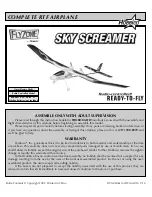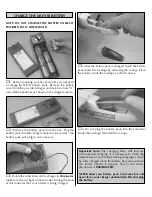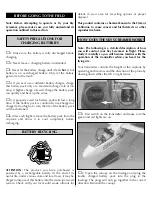
❏
2. Make sure the battery pack is fully charged and
that the transmitter has fresh “AA” batteries installed.
❏
3. If others are flying in the same area, make sure that
they are not using the same channel radio system you
are. The front of your transmitter has a tag with a
number on it. This is the channel frequency you are
using. If someone is on the same frequency,
DO NOT
switch on your transmitter until they are done flying.
❏
1.
Caution:
Always launch the airplane away from
people and obstacles. It is important to adjust or "trim,"
your airplane before each flight. Select an open area to
test your plane.
❏
2. With the motor off, grasp the airplane fuselage and
gently toss the airplane into the wind. It should glide
straight ahead and settle gently to the ground. See the
diagram below. If your plane dives (A) or stalls (B)
follow the steps included below until you have a correct
path (C).
A = Dive.
B = Stall and crash.
C = Correct flight path.
Note: If your airplane flies flat and level the first time,
DO NOT make any further adjustments!
❏
3. If your airplane does not glide on path (C), using a
hobby knife, carefully cut along the sides of the elevator
and top and bottom of the rudders. Repeat step 2 until
proper flight is achieved.
If you have an airplane that follows either path (A) or
(B), cut the sides of BOTH elevators as shown in the photo
above.
If your airplane follows path (A), bend both elevator tabs
up equally.
If your airplane follows path (B), bend both elevators
down equally.
D = Airplane turns left.
E = Airplane turns right.
RUDDER TRIMMING
ELEVATOR TRIMMING
10












